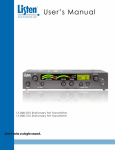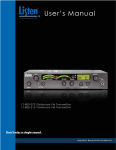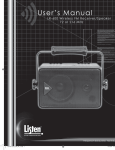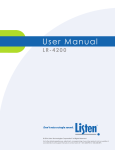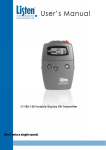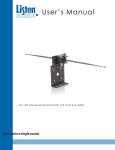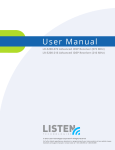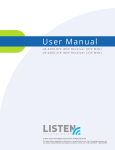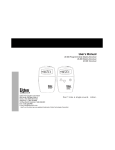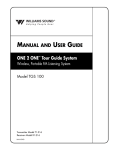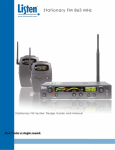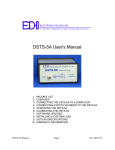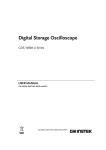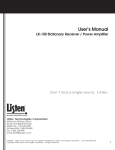Download LT-800 User`s Manual - Barinas Translation Consultants, Inc.
Transcript
User’s Manual LT-800 Stationary Transmitter Don’t miss a single sound. Listen. Listen Technologies Corporation 8535 South 700 West, Suite A Sandy, Utah 84070-2515 USA Telephone: +1.801.233.8992 Toll Free (North America): 1.800.330.0891 Fax: +1.801.233.8995 E-mail: [email protected] Listen® and the Listen logo are registered trademarks of Listen Technologies Corporation Welcome to Listen! Dear Valued Customer, Thank you for choosing Listen! All of us at Listen are dedicated to providing you the highest quality products and prompt, efficient customer care. Our products are manufactured in an ISO-9000 factory that has been independently certified to the highest quality standards. We stand ready to answer any questions you might have during installation or in the operation of our products. Should there be any problems with your Listen products, we are ready to help you in any way we can. Should you have any comments on how we might improve our products or our service, we’re here to listen. Here’s how to reach us: Telephone: +1.801.233.8992 Fax: 1.801.233.8995 Toll Free (North America): 1.800.330.0891 E-Mail: [email protected] Web: www.ListenTech.com Thank you... and enjoy your listening experience! Best regards, The Listen Team LT-800 Package Contents Listen Part Number · · · · · 72 MHz: LT-800-072 216 MHz: LT-800-216 LT-800 Stationary Transmitter (72MHz or 216MHz) LA-201 120 VAC Power Supply LA-121 BNC Adapter (72MHz model only) Warranty Card User Manual Optional Accessories See page 18 i Listen™ and the Listen Logo are registered trademarks of Listen Technologies Corporation. LT-800_2004_01_18 © 2004 Listen Technologies Corporation. All Rights Reserved. Architectural Specifications . . . . . . . . . . . . . . . . . . . . . . . . . . . . . . . . . . . . . . . . . . .2 Specifications . . . . . . . . . . . . . . . . . . . . . . . . . . . . . . . . . . . . . . . . . . . . . . . . . . . . . . .2 Block Diagram . . . . . . . . . . . . . . . . . . . . . . . . . . . . . . . . . . . . . . . . . . . . . . . . . . . . . .3 Quick Reference . . . . . . . . . . . . . . . . . . . . . . . . . . . . . . . . . . . . . . . . . . . . . . . . . . . .4 Setup Instructions . . . . . . . . . . . . . . . . . . . . . . . . . . . . . . . . . . . . . . . . . . . . . . . . . . .5 Audio Control . . . . . . . . . . . . . . . . . . . . . . . . . . . . . . . . . . . . . . . . . . . . . . . . . . . . . .6 Operating Instructions . . . . . . . . . . . . . . . . . . . . . . . . . . . . . . . . . . . . . . . . . . . . . . .7 Transmission . . . . . . . . . . . . . . . . . . . . . . . . . . . . . . . . . . . . . . . . . . . . . . . . . . . . . . .7 Listen SQ™ . . . . . . . . . . . . . . . . . . . . . . . . . . . . . . . . . . . . . . . . . . . . . . . . . . . . . . . .8 Channel Selection . . . . . . . . . . . . . . . . . . . . . . . . . . . . . . . . . . . . . . . . . . . . . . . . . . .9 RF Reception Maximization Strategies . . . . . . . . . . . . . . . . . . . . . . . . . . . . . . . . .10 Coaxial Cable . . . . . . . . . . . . . . . . . . . . . . . . . . . . . . . . . . . . . . . . . . . . . . . . . . . . .11 72 MHz Frequency Compatibility Table . . . . . . . . . . . . . . . . . . . . . . . . . . . . . . . . .12 216 MHz Frequency Compatibility Table . . . . . . . . . . . . . . . . . . . . . . . . . . . . . . . .13 Troubleshooting . . . . . . . . . . . . . . . . . . . . . . . . . . . . . . . . . . . . . . . . . . . . . . . . . . . .14 Compliance Notice . . . . . . . . . . . . . . . . . . . . . . . . . . . . . . . . . . . . . . . . . . . . . . . . .16 FCC Statement . . . . . . . . . . . . . . . . . . . . . . . . . . . . . . . . . . . . . . . . . . . . . . . . . . . .16 Warranty . . . . . . . . . . . . . . . . . . . . . . . . . . . . . . . . . . . . . . . . . . . . . . . . . . . . . . . . .17 Optional Accessories . . . . . . . . . . . . . . . . . . . . . . . . . . . . . . . . . . . . . . . . . . . . . . . .18 Table of Contents Table of Contents Specifications Specifications Architectural Specifications The stationary FM transmitter shall be capable of broadcasting on 57 channels. The transmitter shall have a SNR of 80dB or greater. The output power shall be adjustable to quarter, half or full. Channel tuning shall be capable of being locked. The device shall broadcast on both wide and narrow band channels. The device shall have an audio frequency response of 63Hz to 15KHz, ± 3dB at 72MHz, or of 63Hz to 10kHz, ± 3dB at 216MHz. It shall have two mixing audio inputs. The device shall have the following audio controls: input level, mix level and an adjustable low pass shelving filter. The Listen LT-800 is specified. Specifications LT-800-072 LT-800-216 RF Frequency Range Specification 72.025 - 75.975 MHz 216.025 - 216.987 MHz Number of Channels 57 (17 wide, 40 narrow) 57 (19 wide, 38 narrow) Frequency Accuracy ± .005% stability 0° to 50°C (32° to 122° F) 50 PPM Transmitter Stability RF Transmitter Range 1,500 ft (457.2m) 3,000 ft (914.4m) Output Power 8,000uV at 3m 100mW (Max allowed by FCC) Antenna Several available. See www.ListenTech.com for details Antenna Connector Compliance Reverse BNC BNC FCC Part 15, Industry Canada ** All system specifications are wireless end-to-end System Frequency Response System Signal to Noise Ratio (A-weighted) System Distortion Audio Audio Input 1 Audio Input 2 Combined Audio Output (Mix) Headphone Output RF Power Selection Set-up Controls Controls User Controls Programming Indicators 63Hz - 10kHz (±3dB) SQ enabled: 80dB; SQ disabled 50dB <2% total harmonic distortion (THD) at 80% deviation Rear panel. Female–XLR and ¼ in combo connector, balanced, -55/0dBu (mic/line) nominal input level adjustable, -30/+21dBu (mic/line) maximum, impedance 1k/20k Ohms (line/mic) Rear panel. One Phono connector, unbalanced, -10/+10dBu (line/speaker) nominal input level adjustable, +30dBu maximum, impedance 100k Ohms Rear panel. One Phono connector, unbalanced, 0dBu nominal output level, +19dBu maximum, impedance 10 Ohms. Front panel. One 3.5mm connector, unbalanced, adjustable output level, +14dBu 250mW, maximum, impedance 32 Ohms. Rear panel. Full, ½, ¼ (see "Output Power" above). Front Panel. Input level, mix level (modulation), contour equalization RF power, test tone, channel UP and DOWN, Input 1: line or mic level, Input 2: speaker or line level. Channel selection can be locked by holding the UP and DOWN button 5 seconds. Dual Ten step LED (eight green, two red) Ten step LED (eight green, two red) Four step green LED Green LED illuminates when the unit is powered up Channel and lock status Red LED illuminates when test tone enabled Power Power Supply Type Power Supply Input Power Supply Output Power Supply Connector Compliance In-line power supply, Listen part number LA-201 120VAC, 60 Hz, 19 watts (maximum continuous) 15VAC, 1A .02 in OD x .01in ID (5.0mm x 2.5mm), barrel type UL Listed 8.0 in x 8.0 in x 1.75 in WxDxH (20.3cm x 20.cm x 4.45cm) 3.0 lbs (1.4kg) Physical Dimensions Unit Weight Unit Weight with LA-201 Power Supply Shipping Weight Rack Mounting Temperature - Operation Temperature - Storage Humidity -10° to +40°C (14° to 104°F) -20° to +50°C (-4° to 122° F) 0 to 95% relative humidity, non-condensing Environmental 2 Input VU Meter Mix VU Meter RF Power Power LCD Display Test Tone 63Hz - 15kHz (±3dB) SQ enabled: 80dB; SQ disabled 60dB 4.4 lbs (2.0kg) 5.0 lbs (2.3 kg) ½ rack unit (RU) Block Diagram LT-800 Block Diagram POWER Red LED On Off CHANNEL In-Line Power Supply LA-201 115VAC 60Hz Up (provided) 15VAC, 1A Power Supply CPU Module Down Red LED TEST TONE Listen LED Display On/Off 12VDC 400Hz Top Mounted Antenna Stud (Antenna not provided) Input 1 VU Meter Remote Antenna (Antenna not provided) BNC Line MIX LEVEL Transmitter RF Board 1/Sleeve 3/Ring Mic SQ Pre-emphasis ANTENNA INPUT 1 2/Tip Front Panel Pan Pot Mid Hi Low VU Meter On Input 1 Level Select Line, Mic Off Female XLR-¼" Combo Connector Line, -10dBu INPUT 2 CONTOUR RF POWER SQ SQ Switch is internal (diagonal left and front of Antenna Stud) Phono Input 2 Speaker, +10dBu Input 2 VU Meter Input 2 Level Select Line, Speaker MIX OUTPUT Phono Volume 3.5mm Stereo MONITOR 3 Quick Reference Quick Reference LT-800 Front Panel: Controls & Displays Top antenna connection: Remove rubber plug and screw antenna in place. Indicates RF output power (full, Adjust audio input levels of Indicates audio input ½ or ¼) - select INPUT 1 and INPUT 2 here. level of INPUT 1 and on rear panel (see See page 6 for more INPUT 2 Shows MIX below) information. Audio level Power ON / OFF TEST TONE: Activates a tone to aid system setup (cannot be heard on monitor jack) MIX LEVEL: Adjust so the Mix Level meter occasionally lights the RED LED Shows which channel is selected If decimal is lit, channel is locked Plug in a headset and adjust volume CONTOUR: Equalization adjustment. Turn counter-clockwise for voice and clockwise for music CHANNEL SELECT TO LOCK CHANNEL: press UP and DOWN buttons simultaneously and hold for 5 seconds. Press both and hold again to unlock. LT-800 Back Panel: Connections and Settings REMOTE ANTENNA CONNECTION: See the Listen website for details on antennas that can be attached here. Set RF Power level here (¼, ½ and Full). See page 5 for guidelines on setting power levels. 4 AUDIO OUTPUT: This connector contains a mix of INPUT 1 and INPUT 2. This is an unbalanced phono connector; the output level is -10dBu. The Listen LA-201 power supply connects here. Set switch to match your INPUT 2 source. The level in the LINE position is -10dBu and in the SPEAKER position, it is +10dBu. INPUT 2: This unbalanced phono connector is used to connect an unbalanced high impedance line or speaker input. INPUT 1: Used for balanced connection of a microphone or line level input. This combination connector accepts either XLR or ¼” phone plugs. Select MIC or LINE input here for INPUT 1. Mic input level is -55dBu, in the LINE position, the input level is +4dBu. Setup LT-800 Setup Instructions Remove the product Remove outer packaging and plastic cover. Inspect for physical damage. Set SQ Switch The SQ switch comes in the ON position. This is the recommended position. Make sure receivers you are using have SQ on as well (factory default). See page 8 for an explanation of SQ. Remove the rubber plug from the top of the unit. In a good light, locate the SQ switch through the antenna opening in the top of the unit. The switch is located next to the antenna connector inside the unit. Move the switch toward the front of the unit to enable SQ; move the switch toward the back of unit to disable SQ. Connect power supply to unit Plug the power supply into the power connector on the back panel. Do not connect to AC power yet. (Only use a Listen approved power supply. The LA-201, an in-line transformer, is the approved power supply for this unit.) Connect antenna Connect the antenna (not included) according to the installation instructions. Only use an antenna supplied by Listen. If you are connecting the antenna directly to the top of the LT-800, you will need to remove the rubber plug on top of the unit. If you are using a remote antenna connected to the rear of the unit, do not connect an antenna to the top connector. See page 18 for antenna options, or refer to the Listen website for remote antenna options. LT-800 with top mount LA-102-072MHz, LA-106-216MHz Telescoping Antenna connected through top of unit. Note: If you will be using your LT-800 with receivers that do not have SQ capability, disable the SQ feature. For rack mounting If rack mounting the unit, install the optional rack mount kit (part# LA-326) according to the instructions included with the kit, then install the LT800 in the rack. Rack Mount with dual unit installed Shown with LR-100 and LT-800 Rack Mount with single unit installed Shown with LT-800 LA-122 Remote Antenna See RF Reception Maximization Strategies and Coaxial Cable on pages 10 and 11. Set the RF power Set the RF POWER switch for FULL, ½ or ¼. (Level is indicated on the front panel.) The amount of transmitted RF power that you will need depends on your application. If you are operating other transmitters in the same environment and receivers may be used close to the antenna, it is best to have the transmitter’s output power at its lowest level to reduce the possibility of interference. Rear of LT-800 unit 5 Setup / Audio Control LT-800 Setup Instructions Power up a. Connect the LA-201 power supply to AC power. b. Press the POWER button on the front panel. c. Select the desired channel using the UP and DOWN buttons. d. If desired, lock in the selected channel by pressing the UP and DOWN buttons simultaneously and holding for 5 seconds. Press POWER button and verify power connections. When “ON”, channel display LED will be lit. Connect Audio Inputs Connect audio source(s) to one or both audio input connections. Input 1 offers a choice of balanced XLR or ¼” phono connection. Input 2 is an unbalanced phono connector. Connect balanced and unbalanced audio sources Make sure that if you are connecting an unbalanced audio source to input 1 that pin 3 of the XLR or the ring of the ¼” phone plug are connected to ground as shown. Adjust audio input switches With Input 1 Switch, select MIC or LINE input level; for Input 2 Switch, select LINE (-10dBu) or speaker (+10dBu) level. (See illustration on page 4.) Use the headset jack to listen to audio source: With the audio source or sources active and the unit powered ON, plug a headset into the 3.5mm jack located on the LT-800’s front panel to listen to the audio source. Adjust headset volume to a comfortable level. Input levels can be viewed on the two VU meters on the front panel. LT-800 Audio Control 1 Rear of LT-800 with XLR connected to Input 1 XLR Wiring - + 6 ¼” Phone Wiring 3 2 Adjust input Adjust the INPUT knob counterclockwise to add gain to INPUT 1. This will decrease gain to input 2. Adjust INPUT knob clockwise to add gain to INPUT 2. This will decrease gain to input 1. If you have two audio sources connected to both INPUT 1 and 2, adjust the level of one input using the VU meter, then adjust the output level of the other audio source. Adjust the audio level so that the first VU meter does NOT peak in the red. Adjust Contour Adjust the CONTOUR knob counterclockwise if your audio source is mostly voice. Adjust the knob clockwise if your audio source is mostly music. The CONTOUR knob adjusts the relative equalization of the unit. This equalization boosts or cuts frequencies above 5kHz. Adjust Mix Level Adjust the mix level knob so that the audio level on the right VU meter occasionally peaks red. (This is the level adjustment for the combined output from Input 1 and Input 2.) LT-800 Transmission Power unit on Compatibility with other manufacturers If you are using another manufacturers’ receivers with the LT-800, determine their frequency then refer to Listen’s Frequency Compatibility Tables (pages 12-13) to find the LT-800 channel that corresponds with the receiver’s frequency. As much as possible, Listen has duplicated the wide band channel letters to cover frequencies of other major brands. However, we recommend verifying corresponding channel numbers and letters on the tables on pages 12-13. Select a channel Select the transmit channel by pressing the channel UP and DOWN buttons. See Channel Selection on page 9 for more information. Operation / Transmission Operating the LT-800 UP and DOWN buttons Can’t change the channel? It may be locked. Press and hold both the UP and DOWN buttons simultaneously for 5 seconds until the decimal dot next to the channel turns off. Press again to lock in a new channel, if desired. Test Tone, if necessary To broadcast a test tone, press the test tone button. This helps to test receivers when no audio source is available. This tone is not heard from the monitor jack. 7 Listen SQ™ Listen SQ™- Improving Your Listening Experience We are accustomed to listening to low noise, high fidelity audio (delivered via CD, DVD, etc.). FM radio systems, such as those made by Listen, have more inherent noise compared to most sound systems. To reduce noise of our systems, Listen uses a noise reduction technology called ListenSQ™. Both the transmitter and receiver must have the SQ feature enabled to achieve the desired results. SQ is available on new Listen systems, including the system you received in this shipment. If you are planning to use this product with older Listen systems that do not have Listen SQ or equipment not manufactured by Listen, you should disable Listen SQ. Your Listen equipment has been shipped to you with the SQ feature enabled. You may need to disable the SQ function for one or more of the following reasons: SQ Summary · Improves noise performance by at least 20dB · SQ is NOT compatible with older version Listen products · SQ is NOT compatible with other manufacturers’ products · SQ is NOT squelch 8 1. You are using your new Listen system with older version Listen equipment that does not have the SQ function. 2. You are using your new Listen system with equipment supplied by other manufacturers. 3. You expect that end users may bring and use their own receivers that don’t have the SQ function. · To work properly, SQ must be enabled for both the transmitter and receivers · SQ can be disabled to permit operation with older Listen products or other manufacturers’ products Channel Selection Channel Selection It is important to choose channels that are free from interference to achieve proper operation of your Listen equipment. This process is trial and error. Before turning on the transmitter, listen to the wide band channels (lettered channels at 72MHz and channels that start with a “2” for 216MHz when using a Listen receiver). Listen to the audio through the headphone or via the speaker. Choose a channel with the least amount of interface. Unless you are interfacing with an existing narrowband transmission system, always use a wide band channel. If you are using multiple channels follow this process: a. Same Space If you are using multiple transmitters in the same space, the most number of channels that will work simultaneously is six at 72MHz and three at 216MHz. With all of the transmitters off, listen for interference on all the wide band channels via the headphone jack on a Listen receiver. Using the frequency compatibility tables on pages 12-13, eliminate any channels that have noticeable interference. Now choose the channels with the widest channel spacing. It is recommended that adjacent channels be spaced at least 300KHz. If there is no interference the following channels are recommended: A, C, E, I, J, and H for 72MHz and channels 2A, 2K and 2V at 216MHz. b. Distributed Spacing If you are using transmitters that are spread out over space, you can achieve more simultaneous broadcast channels. However, it is critical that your receiver(s) be located as close to its transmitter as possible. You can use adjacent channels (see frequency compatibility tables on pages 1213) in this case as long as the adjacent channel transmitter is at least 50% further away from the receiver as its transmitter. Example: The transmitter for the receiver on channel E is 100 feet from the receiver. The adjacent channel transmitter on channel D should be at least 150 feet away. Wide Band Recommendation Listen recommends that you always use a wide band channel unless you need to be compatible with existing narrow band receivers from other manufacturers. Wide band channels have lower noise than their narrow band counterparts. At 72MHz The LT-800 at 72MHz operates on 17 wide band channels and 40 narrow band channels. · Letters= Wide Band Channels (Example: E) · Numbers= Narrow Band Channels (Example: 32) At 216MHz The LT-800 at 216MHz operates on 19 wide band channels and 38 narrow band channels. · “2” as left digit= Wide Band · Channel (Example: 2C) “1” and “3” as left digits= Narrow Band Channels (Examples: 1A; 3R) It is highly recommended that after channel selection has been achieved, you lock the channel so that it cannot be changed by the user. To accomplish LOCK on the LT-800, press both the UP and DOWN buttons simultaneously for 5 seconds. Repeat the process to unlock. Notes in regard to using 72MHz and 216MHz systems: i. 72MHz in a secondary frequency band. This means that other transmitters are licensed to use these frequencies. Thus, you may experience interference from paging transmitters and other types of transmissions. You will need to find a clear channel by listening to all the wide band channels. ii. 216MHz is a primary frequency band and no other types of transmissions are authorized to use it. Thus, you will find the highest probability of clear channels in this band. However, you may experience intermodulation of the TV Channel 13 aural carrier if there is a channel 13 transmitter in your area and you are close to the transmitter. If you cannot find a clear channel in 216MHz band due to channel 13, it is recommended that you switch to a 72MHz system. 9 RF Reception Strategies RF Reception Maximization Strategies For proper and dependable operation, Listen receivers should receive a strong and consistent signal from the originating transmitter. The following strategies should be used maximize this signal: a. When designing and installing your system, keep in mind that the location of both the transmitting and receiving antennas is critical to maximizing signal strength. b. Eliminate or minimize obstructions between the transmitting antenna and the receiving antenna. c. Minimize the distance between the transmitting and receiving antennas. d. Move transmitting and receiving antennas away from metal objects. e. Place the transmitting antenna as high as possible. f. Orient both transmitting and receiving antennas vertically. CAUTION: When installing antennas, ensure the antenna is clear of power lines. NOTE: If the RF signal to the 216MHz model receivers is too high, the audio will be distorted. This may happen if you are within 40 feet of the 216MHz transmitter. Coaxial cable, connectors, and optional antenna mounting kits are available from Listen. Visit www.ListenTech.com or ask your dealer for details. 10 Coaxial Cable Coaxial Cable The antenna for the LT-800 can be mounted directly on the unit if desired. However, you may find that the unit will provide better performance when the antenna is located elsewhere. If you plan to mount the antenna in a different location than on the top of the unit, you must use cable and connectors rated at 50 Ohms. Although cable used for cable TV installations looks similar to this cable, it won’t work with your Listen system. If you need to run cable over a greater length than 50 feet for 216MHz applications or greater than 100 feet for 72MHz applications, we recommend that you use RG-8 cable rather than RG-58. It is a lower loss cable, meaning that more of your signal will reach the antenna. Long cable runs can result in signal degradation due to “loss” characteristics of the cable. At 72MHz, there is an average loss of 2dB per 100 feet of cable and at 216MHz an average* loss of 5 dB per 100 feet of cable. (A 3dB loss means half of your power has been lost.) However, it is better to suffer coaxial power loss than to try to shoot your signal through obstacles! Obstacles, especially metal, can create drop-outs or reflections of your signal that will result in poor listening conditions. *NOTE: There are many varieties of 50 Ohm, RG58 and RG8 cables. You may purchase a cable that is better or worse than this value. Please check with the cable vendor or manufacturer for exact specifications. 11 72MHz Compatibility Chart 72MHz Compatibility Chart Frequency MHz 12 72.0250 72.0500 72.0750 72.1000 72.1250 72.1500 72.1750 72.2000 72.2250 72.2500 72.2750 72.3000 72.3250 72.3500 72.3750 72.4000 72.4250 72.4500 72.4750 72.5000 72.5250 72.5500 72.5750 72.6000 72.6250 72.6500 72.6750 72.7000 72.7250 72.7500 72.7750 72.8000 72.8250 72.8500 72.8750 72.9000 72.9250 72.9500 72.9750 74.6250 74.6500 74.6750 74.7000 74.7250 74.7500 74.7750 75.2250 75.2500 75.2750 75.3000 75.3250 75.3500 75.3750 75.4000 75.4250 75.4500 75.4750 75.5000 75.5250 75.5500 75.5750 75.6000 75.6250 75.6500 75.6750 75.7000 75.7250 75.7500 75.7750 75.8000 75.8250 75.8500 75.8750 75.9000 75.9250 75.9500 75.9750 Listen Phonic Ear Comtek Phonak Williams* 1 1 1 A1 2 A 3 2 A 3 2 A 3 A2 A A3 4 K 5 4 K 5 4 K 5 A4 K K5 6 B 7 6 B 7 6 B 7 K6 B B7 8 N 9 8 N 9 8 N 9 B8 N N9 10 C 11 10 C 11 10 C 11 N0 C C1 12 O 13 12 O 13 12 O 13 C2 O O2 14 D 15 14 D 15 14 D 15 4 D D5 16 P 17 16 P 17 16 P 17 D6 P P7 18 E 19 18 E 19 18 E 19 P8 E E9 20 33 20 33 20 33 E0 E3 34 I 35 34 I 35 34 I 35 E4 I I5 36 37 36 37 36 37 I6 I7 38 J 39 38 J 39 38 J 39 I8 J J9 40 R 21 40 R 21 40 R 21 J0 R R1 22 F 23 22 F 23 22 F 23 R2 F F3 24 S 25 24 S 25 24 S 25 F4 S S5 26 G 27 26 G 27 26 G 27 S6 G G7 28 T 29 28 T 29 28 T 29 G8 T T9 30 H 31 30 H 31 30 H 31 T0 H H1 (11, 1) (2) (12, 3) A, (13, 4) (14, 5) (6) (15, 7) K, (8) (16, 9) (10) (17, 11) B, (18, 12) (19, 13) (14) (20, 15) N, (16) (21, 17) (18) (22, 19) C, (23, 20) (24, 21) (22) (25, 33) O, (24) (26, 25) (26) (27) D, (28) (29) (30) (30, 31) P, (32) (31, 33) (34) (32, 35) E, (33, 36) (34, 37) (38) (35, 39) (36, 40) (41) (37, 42) I, (38, 43) (39, 44) (45) (40, 46) (41, 47) (48) (42, 49) J, (43, 50) (55, 51) (52) (45, 53) R, (54) (46, 55) (56) (47, 57) F, (48, 58) (49, 59) (60) (50, 61) S, (62) (51, 63) (64) (52, 65) G, (53, 66) (54, 67) (68) (55, 69) T, (70) (56, 71) (72) (57, 73) H, (58, 74) (59, 75) (76) (60, 77) 32 32 32 H2 Gentner Telex Drake A 72.1 B 72.2 C 72.3 D 72.4 E 72.5 F 72.6 G 72.7 H 72.8 I 72.9 1 2 3 4 5 6 7 8 9 10 11 12 13 14 15 16 17 18 19 20 21 O 22 23 24 P 25 26 Q 27 28 J 75.5 K 75.6 L 75.7 M 75.8 N 75.9 29 30 31 32 33 34 35 36 37 *Parenthesis indicate T35 and T20 narrowband. NOTE: Wideband frequencies in highlighted rows. 216MHz Compatibility Chart 216MHz Compatibility Chart Frequency MHz Listen 216.0125 216.0250 216.0375 216.0625 216.0750 216.0875 216.1125 216.1250 216.1375 216.1625 216.1750 216.1875 216.2125 216.2250 216.2375 216.2625 216.2750 216.2875 216.3125 216.3250 216.3375 216.3625 216.3750 216.3875 1A 2A 3A 1B 2B 3B 1C 2C 3C 1D 2D 3D 1E 2E 3E 1F 2F 3F 1G 2G 3G 1H 2H 3H 216.4125 216.4250 216.4375 216.5125 216.5250 216.5375 216.5625 216.5750 216.5875 216.6125 216.6250 216.6375 216.6625 216.6750 216.6875 216.7125 216.7250 216.7375 216.7625 216.7750 216.7875 216.8125 216.8250 216.8375 216.8625 216.8750 216.8875 216.9125 216.9250 216.9375 216.9625 216.9750 216.9875 1J 2J 3J 1K 2K 3K 1L 2L 3L 1M 2M 3M 1N 2N 3N 1P 2P 3P 1R 2R 3R 1S 2S 3S 1T 2T 3T 1U 2U 3U 1V 2V 3V Phonic Ear 41 42 43 44 45 46 47 48 49 51 52 53 54 55 56 57 58 59 60 Comtek Phonak 1 41 2 3 42 4 5 43 6 7 44 8 9 45 10 11 46 12 13 47 14 15 48 16 1 41 2 21 42 4 5 43 22 23 44 8 9 45 24 25 46 12 13 47 26 27 48 16 17 49 18 21 51 22 23 52 24 25 53 26 27 54 28 29 55 30 31 56 32 33 57 34 35 58 36 37 59 38 39 60 40 17 49 18 61 29 62 28 52 64 65 53 81 82 54 68 69 55 83 84 56 72 73 57 76 85 58 86 77 59 88 79 60 80 Williams Gentner NOTE: Wideband frequencies in highlighted rows. CSI 1 1 2 10 A 3 6 B 4 14 C 5 2 D 6 11 AVR Light Speed C01 N01 C05 E 7 7 F 8 15 C09 N09 C12 N12 C18 N18 C21 G 9 18 H 10 3 I 11 12 C24 C25 J 12 8 K 13 16 L 14 19 15 4 N64 C29 C32 C33 N72 C37 N77 13 9 17 C39 5 C40 N80 13 Troubleshooting LT-800 Troubleshooting The LT-800 has no power Make sure the LA-201 power transformer is connected to a power source and is connected to the jack marked “Power Input”. Make sure the POWER button is pressed. There is no audio or the audio level is too low Make sure that you have an audio source properly connected to Input 1 and/or Input 2. The Input 1 or Input 2 switches must be in the correct position for the appropriate input level. For example: if you are using the output of a mixer on Input 2, the switch should be in the Line position. If it were to be in the Speaker position, the level would be too low. Also, check the Input knob to ensure it is properly adjusted. You should be able to see the VU meter deflect on Input 1 or Input 2 corresponding with the input level of the audio source. Try connecting a headset to the front panel jack and adjusting the Monitor volume control so that you can listen to the audio source. The audio is distorted Check to make sure you have the input level select switches in the proper position. You may be providing too much audio level for the input stage to handle. Make sure the SQ switch is in the correct position on both the LT-800 and the receivers you are using. If your receivers do not have SQ, make sure the SQ switch inside the top of the LT-800 is turned off (see page 5). There is hum in the audio Make sure you have properly grounded the audio source to the LT-800. Check the connections from the audio source to the LT-800. If you can, try to use a balanced audio source - this will reduce the chance of creating hum. Try connecting a ground from the LT-800 to ground and/or to the ground of the source audio. There is a tone The Test Tone button has been pressed (its LED light is on). Push the Test Tone button to turn off the tone. I cannot change the broadcast channel When the unit is locked, the decimal by the channel indicator is illuminated. The unit is locked. To unlock, press the Up and Down buttons simultaneously for 5 seconds. The Audio Input 1 sounds “tinny” If you are using an unbalanced audio source, make sure Pin 3 on the XLR or the ring on the ¼” plug is grounded (see page 6). I cannot pick up the signal on the receiver Check to make sure the receiver and the transmitter are using the same frequency band (i.e. 72MHz or 216MHz) and that they are on the same channel. Make sure the LT-800 has an antenna connected. Ensure that the receiver has an antenna (LR-500, 400 or 300 headset or LR-100 or 600 antenna). 14 I can pick up the signal on the receiver, but it sounds like it’s not tuned in Check to make sure the transmitter and receiver are on exactly the same channel. It’s a good idea to lock the channels once they have been set. To lock the LT-800, press the UP and DOWN buttons simultaneously for a 5 seconds (see page 6, Power Up instructions). Troubleshooting LT-800 Troubleshooting I’m using another brand of receiver - how do I tell which channel to use? Refer to Listen’s Frequency Compatibility Tables (pages 12-13). Adjust Listen’s transmitter to the same frequency as the other major brand. Since Listen products can access 57 channels, they will most likely receive on the same fixed channel or channels of other major brands. If you are using another brand of receiver, make sure you have turned off the SQ feature on the Listen product(s). There is not sufficient range First make sure that the receivers you are using are operating properly, then make sure that you have an antenna connected either to the top of the LT-800 transmitter or connected to the back of the unit (but not both!). The antenna should be as high as possible and free of obstacles. In addition make sure you are using the correct antenna type for your unit. You might want to use a remote antenna (provided by Listen) that can be mounted on a mast or wall. Try using different frequencies to find one with less interference. There is interference in my transmission Ensure that the transmitter and receivers are on the same channel. Verify that there are no other transmitters on the same channel or a close channel to the one exhibiting interference. Try different channels until you find a clear channel. If this does not work, try a different frequency band (i.e. if you are using 72MHz, try 216 MHz or vice versa). Please contact Listen support for assistance and a return authorization (RA) number to exchange product (no charge) for alternate frequency equipment. End users are adjusting the unit. First, lock the channel by pressing the UP and DOWN buttons simultaneously for 5 seconds. Consider removing the INPUT, MIX LEVEL and CONTOUR knobs. You can order from Listen a rack mount kit and security cover that will limit access to the unit. If you are using other manufacturers’ receivers and the sound is distorted It is probably because the receiver is not designed to handle the +25kHz deviation of the Listen transmitter. This can be corrected by turning the Mix Level knob down. Another possibility is that you have enabled the SQ function of the LT-800, and this feature is not available in other companies’ products. You will need to disable SQ in this event (see page 5). Several transmitters operating in the same environment For this, you’ll need to choose your transmitting frequencies carefully. See page 9 for more details. Can I have two antenna’s connected to my transmitter? The LT-800 transmitter can use only one antenna connection at a time. You may connect either a top mount antenna through the top antenna port, or a remote antenna connected to the BNC connection on the rear of the unit. If antenna’s are simultaneously connected to both ports the transmitter will have extremely poor broadcast performance and range. 15 Compliance Notice Compliance Notice This device complies with part 15 of the FCC Rules. Operation is subject to the following two conditions: (1) These devices may not cause harmful interference, and (2) these devices must accept any interference received, including interference that may cause undesirable operation. Listen’s LT-800 Transmitter (216MHz only) Listen’s LT-800 transmitter is authorized by rule under the Low Power Radio Service (47 C.F.R. Part 95) and must not cause harmful interference to TV reception or United States Navy SPASUR installations. You do not need an FCC license to operate these transmitters. These transmitters may only be used to provide: auditory assistance to persons with disabilities, persons who require language translation, or persons in educational settings; health care services to the ill; law enforcement tracking services under agreement with a law enforcement agency; or automated maritime telecommunications system (AMTS) network control communications. Two-way voice communications and all other types of uses not mentioned above are expressly prohibited. CAUTION: Changes or modifications not expressly approved by the party responsible for compliance could void the user’s authority to operate Listen’s equipment. FCC Statement This equipment has been tested and found to comply with the limits for a class B digital device, pursuant to part 15 of the FCC Rules. These limits are designed to provide reasonable protection against harmful interference in a residential installation. This equipment generates, uses and can radiate radio frequency energy and if not installed and used in accordance with the instructions, may cause harmful interference to radio communications. However, there is no guarantee that interference will not occur in a particular installation. If this equipment does cause harmful interference to radio or television reception, which can be determined by turning the equipment off and on, the user is encouraged to try to correct the interference by one or more of the following measures: · · · · Reorient or relocate the receiving antenna. Increase the separation between the equipment and receiver. Connect the equipment into an outlet on a circuit different from that to which the receiver is connected. Consult the dealer or an experienced radio/TV technician for help. This equipment has been certified to comply with the limits for a class B computing device, pursuant to FCC and IC Rules. In order to maintain compliance with FCC and IC regulations, shielded cables must be used with this equipment. Operation with non-approved equipment or unshielded cables is likely to result in interference to radio and TV reception. The user is cautioned that changes and modifications made to the equipment without the approval of manufacturer could void the user’s authority to operate this equipment. 16 Warranty Warranty Listen Technologies Corporation (Listen®) warrants the LT-800 Stationary Transmitter to be free from defects in workmanship and material under normal use and conditions for the useful lifetime of the product from date of purchase. This warranty is only available to the original end purchaser of the product and cannot be transferred. Warranty is only valid if warranty card has been returned within 90 days of purchase. This warranty is void if damage occurred because of misuse or if the product has been repaired or modified by anyone other than a factory authorized service technician. Warranty does not cover normal wear and tear on the product or any other physical damage unless the damage was the result of a manufacturing defect. Listen is not liable for consequential damages due to any failure of equipment to perform as intended. Listen shall bear no responsibility or obligation with respect to the manner of use of any equipment sold by it. Listen specifically disclaims and negates any warranty of merchantability or fitness of use of such equipment including, without limitation, any warranty that the use of such equipment for any purpose will comply with applicable laws and regulations. The terms of the warranty are governed by the laws of the state of Utah, USA. Listen will only accept returned products with prepaid shipping and with a return authorization number. To receive a return authorization number call 1.800.330.0891 or +1.801.233.8992. Please see www.ListenTech.com or contact Listen for complete warranty details. 17 Optional Accessories Optional Accessories Other Stationary Unit Antennas Telescoping* 72MHz Helical* (Top Mount) LA-106 for 72MHz or LA-102 for 216MHz (Top Mount) LA-101 for 72MHz 90 Degree Helical 216MHz Ground Plane (Rear Mount) LA-123 for 72MHz or LA-124 for 216MHz (Remote Mount, outdoor) LA-107 for 216MHz LA-122 Universal Antenna Kit The single solution for all of your indoor remote antenna needs. Includes: 72 and 216MHz components; flexible and rigid dipoles and monopole radials; hardware for multiple mounting configurations; and 25 feet (7.6 m) of RG58 coax cable. LT-800 Rack Mount Options LA-326 Rack Mounting Kit* Includes components for single and dual rack configuration and a security cover Antenna Kit for the LA-3 326 Rack Mount Kit LA-125 for 72MHz and LA-126 for 216MHz * Rack mounted units cannot use the LA-106, LA-102 or LA-101 top mounted antenna. 18 Optional Accessories Optional Accessories continued Replacement 115vac/60hZ Power Supply BNC Adapter LA-121 BNC Connector for RG58 BNC Connector for RG8 LA-127 LA-128 LA-201 RG58 Coaxial Cable LA-112 RG8 Low LossCoaxial Cable Installation of BNC Connectors LA-114 LA-113 19 22 Notes Notes 23 Listen Technologies Corporation 8535 South 700 West, Suite A Sandy, Utah 84070-2515 USA Telephone: +1.801.233.8992 Toll Free (North America): 1.800.330.0891 Fax: +1.801.233.8995 E-mail: [email protected]

























